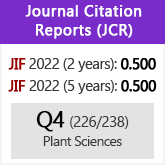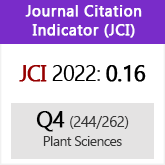Zygostates alleniana (Orchidaceae: Epidendroideae: Cymbidieae: Oncidiinae): Floral structure related to pollinatio
DOI:
https://doi.org/10.3989/ajbm.2378Keywords:
floral oils, oil-collecting bees, Argentina, callus, stipite, rewards, floral visitors, pollination, elaiophoreAbstract
The genus Zygostates Lindl. (Orchidaceae) comprises about 20 species of small Neotropical epiphytic plants, represented in its southernmost limit by the species Z. alleniana. In this paper, we studied morphological and anatomical floral characteristics of this species related to pollination mechanism. We confirmed the presence of the unicellular trichomes on the base of the lip and side lobes secreting oil, constituting a trichomal elaiophore. The oil is deposited beneath the cuticle at the apex of the trichomes forming small blisters. The oil could represent a reward for the species Lophopedia nigrispinis, which would be a potential pollinator of Z. alleniana in a natural area within the geographic range of this plant species. Moreover, we prove that the reconfiguration of the pollinaruim is due to the dehydration of the walls cell. This reconfiguration could favor cross-pollination mechanism already described for other species of the family Orchidaceae. Finally, we discuss the floral characters present in Z. alleniana with closely related species.
Downloads
References
Aguiar, A. 2009. Taxonomic revision of the bee genus Lophopedia Michener and Moure (Hymenoptera, Apidae, Tapinotaspidini). Zootaxa 2193: 1-52.
Aliscioni, S.S., Torretta, J.P., Bello, M. & Galati, B.G. 2009. Elaiophores in Gomesa bifolia (Sims) M.W. Chase & N.H. Williams (Oncidiinae: Cymbidieae: Orchidaceae): structure and oil secretion. Annals of Botany 104: 1141-1149. http://dx.doi.org/10.1093/aob/mcp199
Blanco, M.A., Davies, K.L., Stpiczynska, M., Carlsward, B.S., Ionta, G.M. & Gerlach, G. 2013. Floral elaiophores in Lockhartia Hook. (Orchidaceae: Oncidiinae): their distribution, diversity and anatomy. Annals of Botany, http://dx.doi.org/10.1093/aob/mct232
Buchmann, S.L. 1987. The ecology of oil flowers and their bees. Annual Review of Ecology and Systematics 18: 343-369. http://dx.doi.org/10.1146/annurev.es.18.110187.002015
Chase, M.W., Barrett, R.L., Cameron, K.N. & Freudenstein, J.V. 2003. DNA data and Orchidaceae systematics: a new phylogenetic classification. En K.M. Dixon (ed.), Orchid conservation, pp. 69-89. Natural History Publications, Kota Kinabalu, Sabah.
Chase, M.W. & Toscano de Brito, A.L.V. 2009. Zygostates. En: A.M. Pridgeon & al. (eds.), Genera Orchidacearum, Volume 5: Epidendroideae, pp. 391-394. Oxford University Press, Oxford.
Chase, M.W., Williams, N.H., Faria, A.D., Neubig, K.M., Amaral, M.C.E. & Whitten, W.M. 2009. Floral convergence in Oncidiinae (Cymbidieae; Orchidaceae): an expanded concept of Gomesa and a new genus Nohawilliamsia. Annals of Botany 104: 387-402. http://dx.doi.org/10.1093/aob/mcp067
Cocucci, A.A. 1991. Pollination biology of Nierembergia (Solanaceae). Plant Systematic and Evolution. 174: 17-35. http://dx.doi.org/10.1007/BF00937691
Cocucci, A.A., Sérsic, A. & Roig Alsina, A. 2000. Oil-collecting structures in Tapinotaspidini: their diversity, function and probable origin. Mitteilungen Muenchener Entomologischen Gesellschaft 90: 51-74.
D'Ambrogio de Argüeso, A.C. 1986. Manual de técnicas en histología vegetal. Hemisferio Sur: Buenos Aires.
Darwin, C.R. 1862. On the various contrivances by which British and foreign orchids are fertilised by insects, and on the good effects of intercrossing. John Murray: London.
Davies, K.L. & Stpiczyn´ska M. 2009. Comparative histology of floral elaiophores in the orchids Rudolfiella picta (Schltr.) Hoehne (Maxillariinae sensu lato) and Oncidium ornithorhynchum HBK (Oncidiinae sensu lato). Annals of Botany 104: 221-234. http://dx.doi.org/10.1093/aob/mcp119
Dressler, R.L. 1993. Phylogeny and classification of the orchid family. Dioscorides Press: Oregon.
Endress, P.K. 1998. Diversity and evolutionary biology of tropical flowers. Cambridge University Press: Cambridge.
Gómiz, N.E., Torretta, J.P. & Aliscioni, S.S. 2013. Comparative anatomy of elaiophores and oil secretion in the genus Gomesa (Orchidaceae). Turkish Journal of Botany 37: 859-871. http://dx.doi.org/10.3906/bot-1209-6
Johansen, D.A. 1940, Plant Microtechnique. McGraw-Hill Book Company, Inc: New York.
Johnson, A.E. 2001. Las Orquídeas del Parque Nacional Iguazú. L.O.L.A.: Buenos Aires.
Johnson, S.D., Peter, C.I. & Agren, J. 2004. The effects of nectar addition on pollen removal and geitonogamy in the non-rewarding orchid Anacamptis morio. Proceedings Royal Society B 271: 803-809. http://dx.doi.org/10.1098/rspb.2003.2659
Lovo, J., Winkworth, R.C. & Mello-Silva, R. 2012. New insights into Trimezieae (Iridaceae) phylogeny: What do molecular data tell us? Annals of Botany 110: 689-702. http://dx.doi.org/10.1093/aob/mcs127
Machado, I.C. 2004. Oil-collecting bees and related plants: a review of the studies in the last twenty years and case histories of plants ocurring in NE Brazil. En: B.M. Freitas & al. (eds.), Solitary bees. Conservation, rearing and management for pollination, pp. 255-280. Imprensa Universitária, Fortaleza.
Machado, I.C., Vogel, S. & Lopes, A.V. 2002. Pollination of Angelonia cornigera Hook. (Scrophulariaceae) by long-legged, oil-collecting bees in NE Brazil. Plant Biology 4: 352-359. http://dx.doi.org/10.1055/s-2002-32325
Michener, C.D. 2007. The bees of the World. The Johns Hopkins University Press, Baltimore.
Mickeliunas-Pansarin, L., Morales-Castro M. & Sazima, M. 2009. Osmophore and elaiophores of Grobya amherstiae (Catasetinae, Orchidaceae) and their relation to pollination. Botanical Journal of the Linnean Society 159: 408-415. http://dx.doi.org/10.1111/j.1095-8339.2009.00953.x
Neff, J.L. & Simpson, B.B. 1981. Oil-collecting structures in Anthophoridae (Hymenoptera): morphology, function, and use in systematics. Journal of the Kansas Entomological Society 54: 95-123.
Neubig, K.M., Whitten, W.M., Williams, N.H., Blanco, M.A., Endara, L., Burleigh, J.G., Silveira, K., Cushman, J.C. & Chase, M.W. 2012. Generic recircumscriptions of Oncidiinae (Orchidaceae: Cymbidieae) based on maximum likelihood analysis of combined DNA datasets. Botanical Journal of the Linnean Society 168: 117-146. http://dx.doi.org/10.1111/j.1095-8339.2011.01194.x
O'Brien T.P. & McCully, M.E. 1981. The study of plant structure principles and selected methods. Termarcarphi Pty. Ltd. Melbourne.
Pacek, A. & Stpiczyn´ska, M. 2007. The structure of elaiophores in Oncidium cheirophorum Rchb. f. and Ornithocephalus kruegeri Rchb. f. (Orchidaceae). Acta Agrobotanica 60: 9-14. http://dx.doi.org/10.5586/aa.2007.024
Pacek, A., Stpiczyn´ska, M., Davies, K.L. & Szymczak, G. 2012. Floral elaiophore structure in four representatives of the Ornithocephalus clade (Orchidaceae: Oncidiinae). Annals of Botany 110: 809-820. http://dx.doi.org/10.1093/aob/mcs158
Pansarin, E.M. & Pansarin, L.M. 2011. Reproductive biology of Trichocentrum pumilum: an orchid pollinated by oil-collecting bees. Plant Biology 4: 576-581. http://dx.doi.org/10.1111/j.1438-8677.2010.00420.x
Papadopulos, A.S.T., Powell, M.P., Pupulin, F., Warner, J., Hawkins, J.A., Salamin, N., Chittka, L., Williams, N.H., Whitten, W.M., Loader, D., Valente, L.M., Chase, M.W. & Savolainen, V. 2013. Convergent evolution of floral signals underlies the success of Neotropical orchids. Proceedings of the Royal Society B 280: 20130960. http://dx.doi.org/10.1098/rspb.2013.0960
Peter, C.I. & Johnson, S.D. 2006. Doing the twist: a test of Darwin's cross-pollination hypothesis for pollinarium reconfiguration. Biology Letters 2: 65-68. http://dx.doi.org/10.1098/rsbl.2005.0385
Pijl, L. van der & Dodson, C.H. 1969. Orchid flowers: their pollination and evolution. University of Miami Press: Coral Gables.
Powell, M.P., Pupulin, F., Warner, J., Chase, M.W. & Savolainen, V. 2003. Floral mimicry in Oncidioid orchids. Lankesteriana 7: 109-110.
Reis, M.G., Singer, R.B., Goncalves, R. & Marsaioli, A.J. 2006. The chemical composition of Phymatidium delicatulum and P. tillandsioides (Orchidaceae) floral oils. Natural Product Communications 1: 757-761.
Renner, S.S. & Schaefer, H. 2010. The evolution and loss of oil-offering flowers: new insights from dated phylogenies for angiosperms and bees. Philosophical Transactions of the Royal Society B 365: 423-435. http://dx.doi.org/10.1098/rstb.2009.0229
Roig Alsina, A. 1997. A generic study of the bees of the tribe Tapinotaspidini, with notes on the evolution of their oil-collecting structures (Hymenoptera, Apidae). Mitteilungen Muenchener Entomologischen Gesellschaft 87: 3-21.
Roig Alsina, A. 2000. Clave para las especies argentinas de Centris (Hymenoptera, Apidae), con descripción de nuevas especies y notas sobre distribución. Revista del Museo Argentino de Ciencias Naturales n.s. 2: 171-193.
Sandoval-Zapotitla, E., Terrazas, T. & Villaseñor, J.L. 2010. Diversidad de inclusiones minerales en la subtribu Oncidiinae (Orchidaceae). Revista de Biología Tropical 58: 733-755.
Sazima, M. & Sazima, I. 1989. Oil-gathering bees visit flowers of eglandular morphs of the oil-producing Malpighiaceae. Botanica Acta 102: 106-111. http://dx.doi.org/10.1111/j.1438-8677.1989.tb00073.x
Sérsic, A.N. & Cocucci, A.A. 1999. An unusual kind of nectary in the oil flowers of Monttea: its structure and function. Flora 194: 393-404.
Simpson, B.B. & Neff, J.L. 1981. Floral rewards: alternatives to pollen and nectar. Annals of the Missouri Botanical Garden 68: 301-322. http://dx.doi.org/10.2307/2398800
Simpson, B.B., Neff, J.L. & Seigler, D. 1977. Krameria, free fatty acids and oil-collecting bees. Nature 267: 150-151. http://dx.doi.org/10.1038/267150a0
Singer, R.B. 2009. Morfología floral y polinización de orquídeas: el segundo libro de Charles Darwin. Acta Biológica Colombiana 14: 337-348.
Singer, R.B. & Cocucci, A.A. 1999. Pollination mechanisms in four sympatric southern Brazilian Epidendroideae orchids. Lindleyana 14: 47-56.
Stpiczyn´ska, M., Davies, K.L., & Gregg, A. 2007. Elaiophore diversity in three contrasting members of Oncidiinae (Orchidaceae). Botanical Journal of the Linnean Society 155: 135-148. http://dx.doi.org/10.1111/j.1095-8339.2007.00681.x
Stpiczyn´ska, M. & Davies, K. 2008. Elaiophore structure and oil secretion in flowers of Oncidium trulliferum Lindl. and Ornithophora radicans (Rchb. f.) Garay & Pabst (Oncidiinae: Orchidaceae). Annals of Botany 101: 375-384. http://dx.doi.org/10.1093/aob/mcm297
Stpiczyn´ska, M., Davies, K.L., Pacek-Bieniek, A. & Kamin´ska, M. 2013. Comparative anatomy of the floral elaiophore in representatives of the newly re-circumscribed Gomesa and Oncidium clades (Orchidaceae: Oncidiinae). Annals of Botany 112: 839-854. http://dx.doi.org/10.1093/aob/mct149
Toscano de Brito, A.L.V. 1996. The use of concentrated ammonia as an excellent medium for the restoration of orchid pollinaria: an example from the Ornithocephalinae (Orchidaceae). Lindleyana 11: 205-210.
Toscano de Brito, A.L.V., 2001. Systematic rewiew of the Ornithocephalus group (Oncidiinae; Orchidaceae) with comments on Hofmeisterella. Lindleyana 16: 157-217.
Toscano de Brito, A.L.V. & Kollman, L. 1997. Zygostates leptosepala: a new species in the subtribe Ornithocephalinae (Orchidaceae) from Brazil. Royal Botanic Gardens 52: 239-242.
Vale, A., Navarro, L., Rojas D. & Álvarez, J.C. 2011. Breeding system and pollination by mimicry of the orchid Tolumnia guibertiana in Western Cuba. Plant Species Biology 26: 163-173. http://dx.doi.org/10.1111/j.1442-1984.2011.00322.x
Vogel, S. 1974. Ölblumen und ölsammelnde Bienen. Tropische und Subtropische Pflanzenwelt 7: 285-547.
Vogel, S. 1988. Die Ölblumen – Symbiosen - Parallelismus und andere Aspekte ihrer Entwicklung in Raum und Zeit. Journal of Zoological Systematics and Evolutionary Research 26: 314-362.
Vogel, S. & Cocucci, A.A., 1995. Pollination of Basistemon (Scrophulariaceae) by oil-collecting bees in Argentina. Flora 190: 353-363.
Vogel, S. & Machado, I.C. 1991. Pollination of four sympatric species of Angelonia (Scrophulariaceae) by oil-colecting bees in NE-Brazil. Plant Systematics and Evolution 178: 153-178.
Williams, L.O. 1939. Las Orchidaceae del noroeste argentino. Lilloa 4: 337-375.
Downloads
Published
How to Cite
Issue
Section
License
Copyright (c) 2014 Consejo Superior de Investigaciones Científicas (CSIC)

This work is licensed under a Creative Commons Attribution 4.0 International License.
© CSIC. Manuscripts published in both the printed and online versions of this Journal are the property of Consejo Superior de Investigaciones Científicas, and quoting this source is a requirement for any partial or full reproduction.All contents of this electronic edition, except where otherwise noted, are distributed under a “Creative Commons Attribution 4.0 International” (CC BY 4.0) License. You may read here the basic information and the legal text of the license. The indication of the CC BY 4.0 License must be expressly stated in this way when necessary.
Self-archiving in repositories, personal webpages or similar, of any version other than the published by the Editor, is not allowed.

















